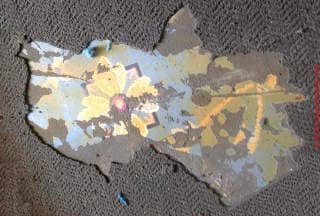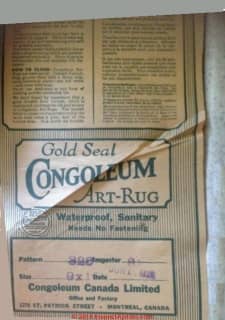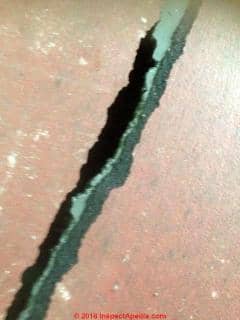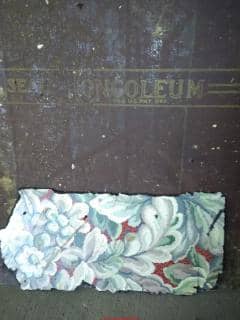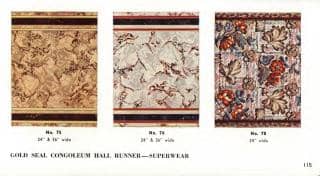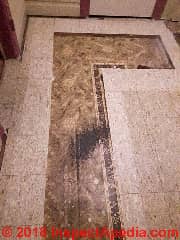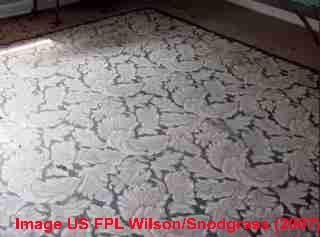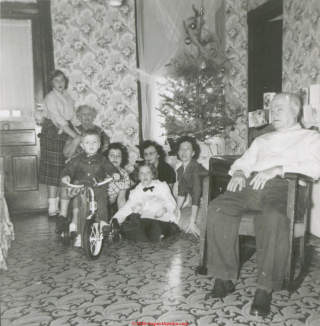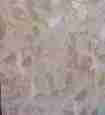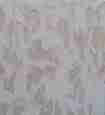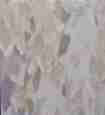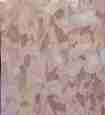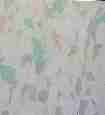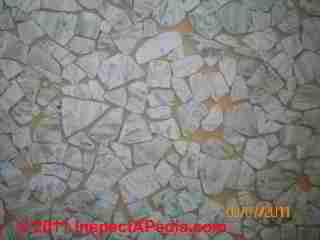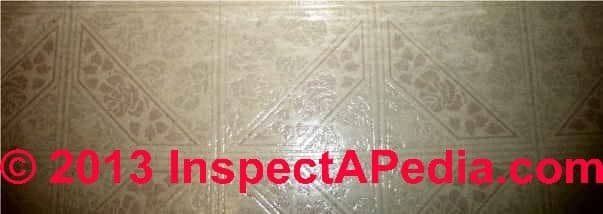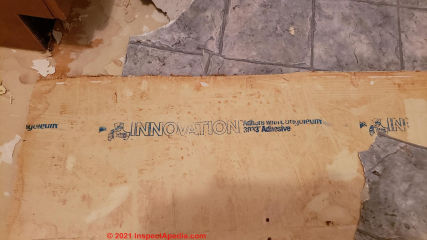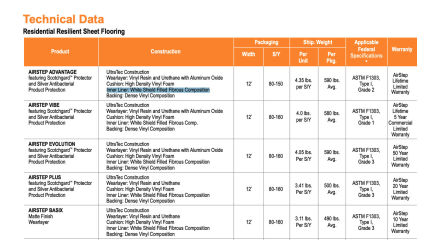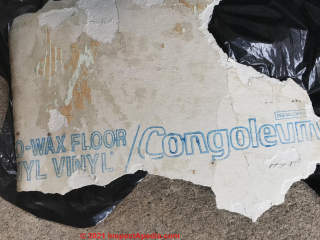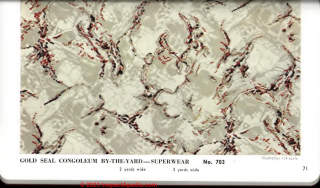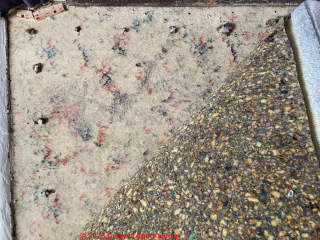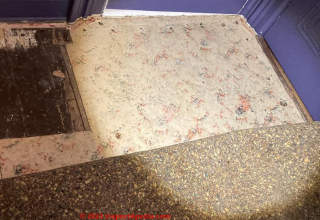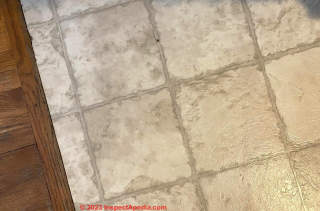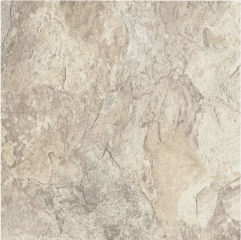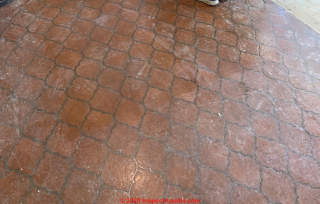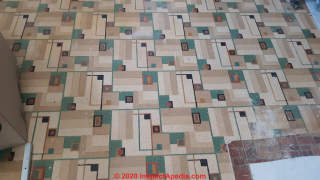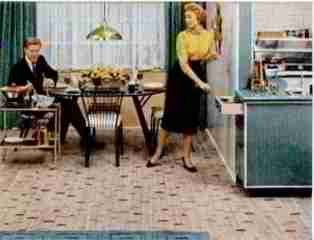 Congoleum Nairn Sheet Flooring & Floor Tile Identification
Congoleum Nairn Sheet Flooring & Floor Tile Identification
Some Congoleum flooring contained asbestos between 1947-1984
- POST a QUESTION or COMMENT about identifying Congoleum or Congoleum Nairn flooring materials & their asbestos content
Congoleum flooring identification:
This article provides a guide to identifying traditional or early Congoleum rugs and other sheet flooring products, Congoleum-Nairn asphalt-asbestos, vinyl asbestos floor tiles, linoleum, and sheet flooring (resilient flooring).
Some of these Congoleum floor covering materials contain asbestos in asbestos fiber or asbestos powder-filler form.
InspectAPedia tolerates no conflicts of interest. We have no relationship with advertisers, products, or services discussed at this website.
Asbestos in Some Congoleum-Nairn Vinyl-Asbestos Floor Tiles & Congoleum Linoleum Sheet Flooring: Resilient Floors
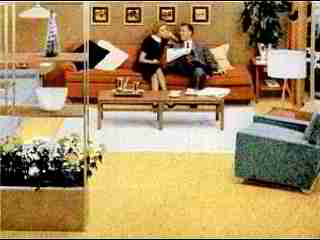 Asbestos was found in at least these Congoleum flooring products: Congoleum-Nairn Flor-Ever Vinyl, Fashionflor Cushioned Vinyl flooring, Gold Seal Vinyl Inlaid flooring, Gold Seal Vinyl Nairon Standard flooring.
Asbestos was found in at least these Congoleum flooring products: Congoleum-Nairn Flor-Ever Vinyl, Fashionflor Cushioned Vinyl flooring, Gold Seal Vinyl Inlaid flooring, Gold Seal Vinyl Nairon Standard flooring.
Asbestos is safe and legal to remain in homes or public buildings as long as the asbestos materials are in good condition and the asbestos can not be released into the air.
SEQUIN PATTERN [image] Congoleum resilient flooring is shown above.
[Click to enlarge any image]
Article contents
Asphalt asbestos Congoleum Nairn & Congoleum Nairn vinyl-asbestos floor tile identification and advice 1917 - 1986
How to recognize Congoleum Nairn floor tiles & linoleum or resilient sheet flooring that may contain asbestos fibers.
We include photographs of Congoleum Nairn asbestos containing floor tiles, sheet flooring, linoleum, and resilient floor coverings as well as photos of products that have been confirmed as asbestos-free.
- CONGOLEUM-NAIRN FLOORING - you are on this page
- 1928 CONGOLEUM RUGS SHEET FLOORING - Canadian Congoleum
- 1940s CONGOLEUM FLORAL RUG PATTERNS
- 1947 CONGOLEUM SHEET FLOORING
- 1940s CONGOLEUM GOLD SEAL RUGS vs. NAIRN LINOLEUM ingredient differences
- 1950 CONGOLEUM GOLD SEAL SHEET FLOORING - No Asbestos
- 1950's CONGOLEM SHEET FLOORING Products Resembling Individual Floor Tiles
- 1960's CONGOLEUM FLOORING - No Asbestos
- 1970's CONGOLEUM FLOORING
- 1970's CONGOLEUM FLOORING in AUSTRALIA
- 1980 CONGOLEUM NO-WAX SHEET FLOORING - With Asbestos-Content.
- CONGOLEUM FLOORING HISTORY - separate page
- IDENTIFY SHEET FLOORING TYPE, HOW TO - identify all types of sheet flooring & flooring backers by type, with or without asbestos
- LINOLEUM & OTHER SHEET FLOORING - separate page, Additional Images of Congoleum linoleum sheet flooring products
- WHITE SHIELD® BACKING ASBESTOS in FLOORING - in older but not modern Congoleum flooring
Congoleum Nairn, was established in 1886, and presently headquartered in Mercerville, NJ, U.S., produced resilient sheet flooring, vinyl asbestos floor tiles in patterns such as their Congoleum-Nairn Romanaire pattern.
Original Congoleum was made from materials imported from the Belgian Congo and was produced in 36" wide strips in a variety of patterns, often bordered.
Watch out: the backing on some of these vinyl flooring or linoleum products may also contain asbestos.
Congoleum Art-Rug, 1928, Congoleum Canada Factory
[Click to enlarge any image]
InspectApedia.com reader Jennifer McKenna has kindly contributed these photographs of Canadian-made a Congoleum Rug along with documentation that included a date stamp of 1 June 1928.
Congoleum Canada, Office & Factory, 1270 Patric St., Montreal, Canada. Photo below includes the date stamp.
This is a traditional red-backed Congoleum Gold-Seal flooring product, as you'll see in the photos. We're hopeful that Ms. McKenna will scrape off more of that old carpet padding to show us the Canadian Congoleum rug pattern in more detail.
Our second Congoleum art rug backer photo above shows a tear in the sheet flooring to reveal its black asphalt-impregnated paper-like backing.
Watch out: some asphalt-impregnated paper backing used on sheet flooring contains asbestos. We have offered to assist in having this 1928 Congoleum Art Rug tested for asbestos and will report here if that occurs.
Research suggests that Congoleum flooring made before 1947 did not contain asbestos.
Also see DOMINION & Other CANADIAN FLOORING ASBESTOS
Congoleum Sheet Flooring ca 1947 - asbestos in some Congoleum '47- '83
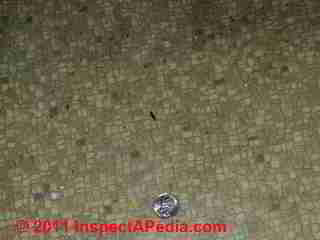 On the other and, several sources list Congoleum flooring manufactured at the company's various factories between 1947 and 1983 as containing asbestos. And that's likely be true.
On the other and, several sources list Congoleum flooring manufactured at the company's various factories between 1947 and 1983 as containing asbestos. And that's likely be true.
Really? Well yes, however as we report below
at 1950 CONGOLEUM GOLD SEAL SHEET FLOORING - No Asbestos was found in some 1950 floor covering products tested.
And similarly a Congoleum sample reported
at 1960's CONGOLEUM FLOORING - was also tested and reported to contain no asbestos.
Congoleum Vinylbest vinyl asbestos floor tiles were produced in the 1950s along with Congoleum Gold Seal inlaid linoleum flooring shown at above left from a Life magazine advertisement, and the Congoleum sheet linoleum shown in a Florida Home (left) provided a scattershot or color fleck pattern.
The Congoleum linoleum photograph shown here of Congoleum sheet flooring installed in a 1949 Tampa Florida home is provided courtesy of M.B.
M.B. placed a U.S. quarter on the flooring to provide a pattern size scale reference. [Click image for a larger view]. [We think the flooring itself may date from the 1960's.]
Other Congoleum products included Vinylfloor, Vinyltop (countertops), Congoleum, CongoWall, Ranchtile, Cork tile, Linoleum tile, Vinyl tile, Rubber tile, and Asphalt tile marketed under the Congoleum Gold Seal trademark.
Congoleum Nairn tile flooring and resilient flooring or linoleum flooring photos wanted - CONTACT US
Congoleum Gold Seal Sheet Flooring ca 1950: test indicated No Asbestos Content
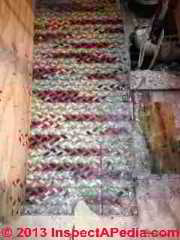
This Congoleum flooring Gold-Seal sheet flooring is dated from the 1950's. Reader C.H. wrote:
I've just discovered an old (and ugly) sheet vinyl in a bathroom floor dating from the early 1950's which is labeled on the back as "Gold Seal Congoleum Trade Marked."
It is not glued down but is hidden under modern vinyl that is glued to a thin plywood which is then stapled through the old stuff into a pine floor.
The suspicious vinyl bends almost double and then breaks easily.
We haven't done any sanding or sawing of it during the demolition of the bathroom (so hope we haven't released any asbestos fibers), but we have disposed of some of the small broken pieces along with other demolition refuse in trash bags at our county dump.
Does this look like an asbestos problem to you guys? Attached are photos of the hideous red/black/gray pattern (the red color actually transferred slightly to the plywood) and of the back of the same piece.
We would welcome any comments or advice. Thanks! - C.H., Clemson, SC 8/18/2013
Reply:
 Certainly there were Congoleum flooring products that did not contain asbestos, and from its appearance we'd suspect your flooring is one of those.
Certainly there were Congoleum flooring products that did not contain asbestos, and from its appearance we'd suspect your flooring is one of those.
But simply from an emailed photograph, and without testing or other information, to be safest I would treat the material as presumed-asbestos-containing material (PACM).
One should not assert for sure the presence or absence of an environmental hazard just from a brief email description. From your description it sounds as if you've handled the matter correctly and that the amount of dust released of any sort would have been trivial.
In particular, a sheet flooring that was not glued down is usually easily removable in large pieces without breakage and dust other than the accumulated dirt and dust debris that accumulates in old building layers and materials.
Watch out: I would recommend using damp mopping or HEPA vacuuming when cleaning up dust and debris from any renovation work on older buildings to control dust as much as possible.
Even when potentially dangerous asbestos or lead particles are not present, there may be other contaminants, allergens, irritants in the dust, even drywall or plaster dust that can be a respiratory irritant.
Note that Congoleum was not the only company to produce rubber-backed sheet flooring in rug patterns.
See ARMSTRONG RUBBER BACKED RUG PATTERNS.
Reader follow-up with asbestos test results: no asbestos in this Congoleum floor sample.
Here is an update on the Congoleum I found under the bathroom floor: just got the results tonight from Western Analytical Lab and there is NO asbestos in the sample I sent them! We are very relieved!
Comment:
Happy results, but not a big surprise. Notice in the photographs of Congoleum Gold Seal flooring above that the product backing material is solid dark red throughout? This is not an asphalt-based felt (and often asbestos-containing) paper backer.
Below we show three more interesting Congoleum Nairn sheet flooring designs from the mid 1950's (excerpted from Life Magazine advertisements).
Below: Congoleum sheet flooring showing rug pattern (front) and the gold Congoleum imprint on the red-backed flooring - photo from another InspectApedia.com reader
Question: is there asbestos in this 1941 Congoleum Gold Seal flooring?
2020/04/23 Luckydog66 said:
Trying to figure out if this has asbestos or not. It’s original to the home from 1941.
Moderator reply: photo of Congoleum Nairn Inc. Gold Seal flooring logo dated 1941.
 We have information about Congoleum Gold Seal, Lucky - now found just above on this page - where a reader tested and confirmed that their Congoleum Gold Seal sheet flooring did not contain asbestos.
We have information about Congoleum Gold Seal, Lucky - now found just above on this page - where a reader tested and confirmed that their Congoleum Gold Seal sheet flooring did not contain asbestos.
So if your flooring is a Congoleum Gold Seal "linoleum" rug similar to that reader's flooring then indeed it may be asbestos free.
Watch out: however you did not show us your flooring, just a product logo.
Congoleum Nairn sold a wide range of products (listed above on this page) under that brand name. Some of them contained asbestos.
Until we know more about just what Congoleum Nairn gold seal product you have installed, or until you have a sample tested, the jury is ... out. Sorry.
More information is also at
1940s CONGOLEUM GOLD SEAL RUGS vs. NAIRN LINOLEUM ingredient differences -
I would be grateful if you'd also post a photo of the Congoleum Gold Seal flooring itself
and if you'd tell us the country and city where it's installed.
Question: does red rubber backed Congoleum Gold Seal flooring contain asbestos?
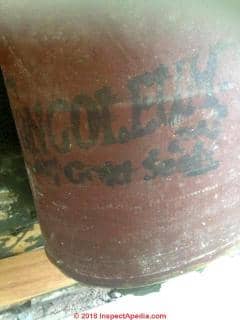 (Mar 23, 2019) Brianastevens86@gmail said:
(Mar 23, 2019) Brianastevens86@gmail said:
Does this contain asbestos thanks
Photo lost - please re-post.
Moderator reply:
Brian,
In the article above, for older Congoleum red rubber-backed sheet flooring we noted that per one reader,
Congoleum Gold Seal Sheet Flooring ca 1950: test indicated No Asbestos Content
I include here one of the photos of the back of that flooring showing the red, asphalt-based backing and the Congoleum Gold Seal logo.
For the asphalt-paper backed sheet flooring (widely described as "linoleum"), our advice is to either have a sample of the flooring tested for asbestos or to presume that it contains asbestos, because at least some asphalt-impregnated felt paper used on buildings and as a flooring backer has been found to contain asbestos.
We'd need to be more-sure of the age and pattern and type of flooring in your question.
Congoleum Sheet Flooring Products Resembling Individual Floor Tiles
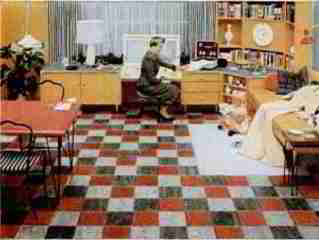
At above is a continuous resilient Congoleum Nairn sheet flooring product that was colored to resemble individual floor tiles in red, black,and white.
The Congoleum-Nairn company advertised that this approach was less costly and quicker to install than tiles, and permitted better control over tile color consistency.
Above you will see our photograph excerpted from another 1950's flooring advertisement shows a Congoleum sheet floor used in a kitchen and dining area.
Congoleum sheet flooring in three foot wide simulated-wood patterns, in "rug" forms intended to be installed without fully extending to the walls of a room, and in larger sheets intended for wall-to-wall installation, were made by bonding a colored pattern layer (similar to linoleum) to a dark or black asphalt-impregnated felt backer layer.
Above: Congoleum Nairn hall runners from the company's 1942 catalog given below. Notice that these hall runners and other sheet flooring products often included a border imprinted in the sheet flooring. Below is a similar and well-worn example provided by an anonymous reader.
Most of this asphalt-felt-backed bordered sheet flooring remains covered by what appears to be a vinyl asbestos floor tile.
While the term linoleum is widely used for sheet flooring, this product is not made of true traditional linoleum ingredients described
Watch out: as we explain at RESILIENT SHEET FLOORING ID GUIDE, asphalt-backed sheet flooring may contain asbestos.
Asphalt-saturated felt (paper) backed flooring, used as early as 1910 in the U.S., looks like but is not true traditional linoleum flooring.
We prefer to refer to Congoleum® flooring and similar products by Armstrong® as asphalt-saturated felt-backed sheet flooring. But we note that many sources call all forms of sheet flooring "linoleum" regardless of composition of the material.
Congoleum Nairn Sheet Flooring Catalogs, Research & Installation Instructions
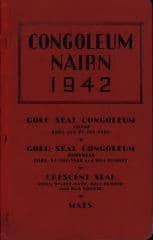 Armstrong's Linoflor, produced beginning in 1937, is an asphalt-based-backer sheet flooring that some referred to and continue to refer to [in my opinion loosely] as "linoleum", adding to the generic use of that word for sheet flooring. - Wilson & Snodgrass, U.S. FPL (2007)
Armstrong's Linoflor, produced beginning in 1937, is an asphalt-based-backer sheet flooring that some referred to and continue to refer to [in my opinion loosely] as "linoleum", adding to the generic use of that word for sheet flooring. - Wilson & Snodgrass, U.S. FPL (2007)
[Click to enlarge any image]
Clicking the 1942 Congoleum catalog image above will load the PDF file of the actual catalog.
- 1960's CONGOLEUM FLOORING - Congoleum Sheet Vinyl Flooring, 1960's: Tested, No Asbestos
- 1970's CONGOLEUM FLOORING - Congoleum Sheet Flooring, 1970's Asbestos Content
- 1970's CONGOLEUM FLOORING in AUSTRALIA - Congoleum Sheet Flooring Backer Text - Australia 1970's - Asbestos?
- CONGOLEUM AIRSTEP INSTALLATION INSTRUCTIONS [PDF] (2013), Congoleum, 3500 Quakerbridge Road, PO BOx 3127, Mercerville NJ 08619 USA, Website: www.congoleum.com, retrieved 2016/04/01, original source: http://www.congoleum.com/uploads/files/dri_installation_guides/AirStep%20Install%20Instructions.pdf - Notice: these instructions warn about older in-place flooring that may contain asbestos fibers.
Excerpt: Unless positively certain that the in-place product is a non-asbestos containing material, you must presume it contains asbestos. Regulations may require that the material be tested to determine asbestos content and may govern removal and disposal of material. - CONGOLEUM DuraStone HPF FLOORING BROCHURE 2012 [PDF] and product specifications, Congoleum Corporation, P.O. Box 3127, Mercerville, NJ 0861 USA, Tel: 609-584-3000 Website: www.congoleum.com
- CONGOLEUM NAIRN 1942 SHEET FLOORING CATALOG [PDF] 124 pages. including Gold Seal Congoleum Deluxe "rugs by the yard", Gold seal Congoleum "Superwear" and Congoleum Nairn Crescent Seal and Mats, retrieved 2018/02/07,
original source: https://ia802507.us.archive.org/15/items/CongoleumNairn1942/CongoleumNairn19420001.pdf Digitized and preserved by AAPI and from Tulane University archives.
You will see that very ornate "rug" patterns were provided in this product series.
Some of these patterns were produced in very similar designs by other manufacturers such as Armstrong, shown at ARMSTRONG SHEET FLOORING 1940 - 1980.
- CONGOLEUM DuraStone HPF FLOORING INSTALLATION INSTRUCTIONS [PDF] un-dated, courtesy of an InspectApedia.com reader
- CONGOLEUM DuraStone HPF FLOORING CARE INSTRUCTIONS [PDF] un-dated, courtesy of an InspectApedia.com reader
- CONGOLEUM FLOOR PRODUCTS CONTAINING ASBESTOS - found in this full list of ASBESTOS PRODUCING COMPANIES & TRUSTS
- CONGOLEUM FLOORING HISTORY - company & product history
- LINOLEUM & Other Sheet Flooring - Additional Images of Congoleum linoleum sheet flooring products
- RESILIENT SHEET FLOORING ID GUIDE - home
- Richa Wilson, Kathleen Snodgrass, " EARLY 20TH-CENTURY BUILDING MATERIALS: RESILIENT FLOORING " [PDF 1.5MB], Richa Wilson, Intermountain Regional Architectural Historian
Kathleen Snodgrass, Project Leader, United States Department of Agriculture Forest Service, Technology & Development Program, August 2007, 7300-0773-2322-MTDC.
Contact Kathie Snodgrass at MTDC: Tel: 406–329–3922, Email: ksnodgrass@fs.fed.us or Richa Wilson, author; USDA Forest Service, Intermountain Region, 324 25th Street, Ogden, UT 84401. Phone: 801–625–5704; fax: 801–625–5229: e-mail: rwilson@fs.fed.us - XII. VINYL-ASBESTOS FLOOR TILE [PDF] retrieved 2018/09/09 (and previously), original source: http://www.pic.int/Portals/5/en/DGDs/Alternatives/USA/American%20alternatives%20part%203.pdf - we are researching the complete document title and original authors. If a reader has that information please use the page top or bottom CONTACT link to contact us.
in
Chrysotile Asbestos, supporting documentation, http://www.pic.int/TheConvention/Chemicals/Recommendedforlisting/Chrysotileasbestos/tabid/1186/language/en-US/Default.aspx
Under the aegis of the:
ROTTERDAM CONVENTION ON THE PRIOR INFORMED CONSENT PROCEDURE FOR CERTAIN HAZARDOUS CHEMICALS AND PESTICIDES IN INTERNATIONAL TRADE
Found in the database collection of
Secretariat of the Rotterdam Convention - UNEP Office address: 11-13, Chemin des Anémones - 1219 Châtelaine, Switzerland Postal address: Avenue de la Paix 8-14, 1211 Genève 10, Switzerland Tel.: +41 (0)22 917 8271 - Fax: +41 (0)22 917 8098 Email: brs@brsmeas.org
Secretariat of the Rotterdam Convention - FAO Viale delle Terme di Caracalla, 00153 Rome, Italy Tel.: +39 06 5703 3765 - Fax: +39 06 5703 3224 Email: pic@fao.org
Congoleum Sheet Flooring Asbestos up to 1984: Asbestos-Content Confirmed
Producers and Importers of Vinyl-Asbestos Floor Tile in 1981-1982
There were six primary processors of this asbestos product in 1981:
Amitco Division of American Biltrite
Armstrong World Industries
Azrock Industries
Congoleum Corp.
Kentile Floors, Inc.,
Tarkett, Inc. (TSCA 1982a).
There were no secondary processors of vinyl-asbestos floor tile, and a survey of importers failed to identify any importers of vinyl-asbestos floor tile (TSCA 1982b, ICF 1984). Al six processors have stopped using asbestos since that time.
Armstrong World Industries had eliminated asbestos by the end of 1983, and Congoleum Corp. had eliminated it in 1984.
Amitco Division of American Biltrite phased out asbestos in 1985 and
Kentile Flors, Inc. phased out the use of asbestos in 1986.
Because none of the other respondents to our survey indicated that they had begun production of vinyl-asbestos floor tile or were aware of any other producers or importers of vinyl-asbestos floor tile, we have concluded that there are currently no domestic producers of this product (ICF 1986). - source: XII. VINYL-ASBESTOS FLOOR TILE [PDF]
Sources: see CONGOLEUM FLOORING RESEARCH, REFERENCES, INSTRUCTIONS on this page.
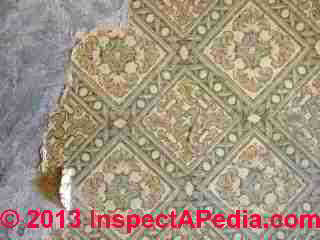
Reader Anonymous wrote: asbestos confirmed in Congoleum floor from 1982
I have attached a photo of some vinyl flooring that I have in my house. I was prepping the floor for new wood and found this underneath.
Unfortunately I scraped some of it out prior to finding out that it could contain asbestos. My house was built in 1982. The vinyl appears to be large sheet vinyl.
The bottom is marked Congoleum™ and the model is Forecast. It also says no wax vinyl. I was unable to find an reference to it in your picture library. I'm currently looking for somebody to test it. I'm hoping to put my mind at ease in the meantime. - Reader G. 8/11/2013
Indeed there were some sheet vinyl products that contained asbestos fibers and filler - typically in the backing and of course in some mastics.
When a home was built close to the end of the era of popular use of these materials I worry that someone could still have installed an asbestos-containing floor product from older stock.
If you are not doing dusty messy demolition the chances of a significant asbestos particle contamination problem are pretty low; we list the best sources of certified asbestos test labs in our article found
Reader follow-up: the sample came back from the lab positive for asbestos. Feel free to pass the info and photos along. - G.
Reply: I'd like to see the actual asbestos test lab report or any quantitative findings given.
Hopefully you didn't create much actual respirable dust during tear-up; my experience with sheet flooring is that the backer is not very friable compared with many other asbestos-containing materials, and though some Congoleum sheet flooring backer did contain asbestos.
Even without a lab test of a flooring sample, the safe procedure for asbestos-suspect flooring installed through the early 1980's is to treat the flooring as PACM - Presumed Asbestos Containing Material.
My OPINION is that actual asbestosis cases traced to residential exposure are slim to none except for family members of workers in the asbestos industry who inadvertently brought home asbestos dust on clothing or in a few oddball cases of workers deliberately using friable asbestos pipe insulation or similar products to "insulate" their own homes "for free" so to speak.
Family member asbestosis / mesothelioma claims relating to industry workers are cited in various legal asbestos exposure lawsuit cases such as
- Amchem Products, Inc. v. Windsor, 521 U.S. 591, 117 S. Ct. 2231, 138 L. Ed. 2d 689 (1997).
- Keene Corp. v. Ins. Co. of North America, 667 F.2d 1034 (D.C. Cir. 1981).
- Karjala v. Johns-Manville Products Corp., 523 F.2d 155 (8th Cir. 1975).
- Beshada v. Johns-Manville Products Corp., 447 A.2d 539, 90 N.J. 191, 150 N.J. Super. 50 (1982).
But I have not yet (8/2013) found scholarly studies nor lawsuit citations involving homeowners / occupants claiming asbestosis or mesothelioma related to exposure to ordinary levels of residential PACM products
Reader Comment on Congoleum No-Wax Flooring Design by Pyright
(June 28, 2014) Mike Padgett said:
I have just removed a vinyl floor I had installed. Underneath that subfloor was another vinyl floor. It is printed with "Congoleum/The No-wax Floor Shiny Vinyl". Above Congoleum it reads: Design by Pyright. The backing appears to be similar to the paper from the vinyl I installed. I have pictures.
Congoleum Gold Seal Rugs and Nairn Linoleum - is there difference in their ingredients?
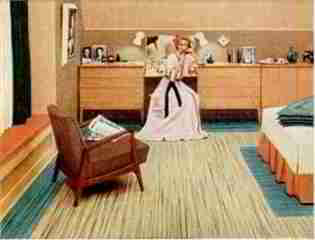
Above: this Congoleum flooring advertisement, also from the 1950's, demonstrated use of sheet flooring to provide a border and carpet image in a bedroom.
Below: an asphalt-saturated felt-based "linoleum rug" from Congoleum developed in North America and sold in the U.S. and Canada as an alternative to more-costly true linoleum.
Floral Pattern Congoleum Rugs
 This photograph of the green and white floral pattern Congoleum rug was provided courtesy of an anonymous reader.
This photograph of the green and white floral pattern Congoleum rug was provided courtesy of an anonymous reader.
Our reader guessed that this floor covering was installed in 1949 and remained there until it was found under other layers of flooring and then removed from its Canadian home in 2017.
Other sheet flooring from the same home and provided by the reader can be seen
a
Felt-based sheet flooring is not a true linoleum - the latter was made from linseed oil and used a jute fabric back.
Shown here, this less expensive type of sheet flooring product first produced by Armstrong is a printed pattern imposed on a felt backer similar to roofing felt or "tar paper" but thicker.
Next we provide another image of a very-similar Congoleum sheet flooring floral rug pattern and product from the US FPL article cited above.
If you look closely you'll see that these two patterns are not precisely identical but both were popular, widely-sold floral pattern "linoleum" rug flooring.
As we caution readers throughout this article series, because some asphalt felt paper products produced in this area contained asbestos we do not assume that these floors are asbestos free.
The next photo (below) shows a a closer-view of what is probably the same floral pattern linoleum-like rug, actually asphalt-felt-backed sheet flooring. This photo was provided by an anonymous reader who reported finding this flooring in a home built ca 1918 or before.
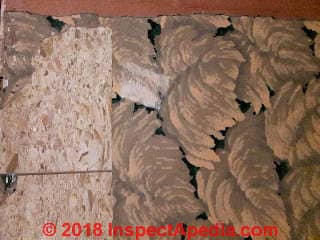 The left side of our photo shows what is almost certainly a vinyl-asbestos floor tile, probably from the 1960's or 1960's.
The left side of our photo shows what is almost certainly a vinyl-asbestos floor tile, probably from the 1960's or 1960's.
For the asphalt-paper backed sheet flooring above (widely described as "linoleum"), our advice is to either have a sample of the flooring tested for asbestos or to presume that it contains asbestos, because at least some asphalt-impregnated felt paper used on buildings and as a flooring backer has been found to contain asbestos.
Avoid making a dusty mess.
Wilson & Snodgrass (2007), in describing the history of resilient flooring both clarify and add examples of the confusion around using the term "linoleum" as generic for sheet flooring.
Those authors note that by 1937 Armstrong Flooring was producing LinoFlor, a printed linoleum product on an asphalt-impregnated paper "felt" backing.
Wilson & Snodgrass, U.S. FPL (2007) have provided some of the history of resilient flooring and have their own photo of this beautiful example of a Congoleum "rug" still in use by the US FPL.
see CONGOLEUM FLOORING RESEARCH, REFERENCES, INSTRUCTIONS
Correctly speaking, in our opinion, some of these sheet flooring products may not be "linoleum" if they were not produced using traditional linoleum ingredients.
More photos of the green and white floral pattern flooring above are
at GREEN WHITE & GRAY FLORAL LINOLEUM
Question: can you identify this flooring type and pattern?
I am researching my family history and came across an old photo. I am trying to identify the pattern name/design in the flooring of this photo.
I think it was between 1930-1940 as that is when they lived in the house but could have been earlier. Is this something that you can help me identify?
Or direct me to where I can go to get help?
Thank You! I have attached the old black and white photo so hopefully this will help.
This Q&A were posted originally at ASBESTOS FLOOR TILE IDENTIFICATION PHOTOS 1949-1959
Moderator reply: Congoleum floral pattern "rug"
That's a "linoleum rug" that was circa 1940. It's a floral pattern by Congoleum. You can see a color version of that very rug above on this page.
Thanks so much for the photo and the question.
Difference between true linoleum and asphalt-backed "linoleum"
The pigments in traditional or true linoleum extended through its thickness, the product was linseed oil based, and it used a jute backing. In contrast, other sheet flooring products were made of a thin pigment or colored pattern layer glued to an asphalt-paper-based or "felt" backer that is black in color and that looks like thick roofing felt.
But many authors and historians including those cited just above refer to most or even all sheet flooring products from this era using the word linoleum. Linoleum, then became rather generic, just as Kleenex™ became generic for tissues among many snifflers.
Really? Why do we care whether an old or historic floor covering is traditional linoleum or some other product made of different ingredients?
Well because at least some older asphalt-impregnated paper felt backing products contained asbestos, while no pure linoleum flooring products contain nor ever contained asbestos in their ingredients.
Congoleum Gold Seal Rugs along with Nairn Linoleum were marketed from the 1920's into the 1950's when Congoleum-Nairn was producing 12-foot wide sheet vinyl-based flooring.
- Colors/Shades of a Congoleum-Nairn 1963 vinyl asbestos flooring style Romanaire 9" x 9" x 1/16" pattern shown (Shade VA 581 above left, Shade VA 577, Shade VA 578, Shade VA 582, Shade VA 580 above right, and Shade VA579 below left) [Note: these image files are mis-named by some websites as Kentile - properly they are Congoleum-Nairn products.]
Don't Confuse Congoleum Nairn Resilient Flooring with Armstrong Floors
Armstrong and Congoleum were and are two distinctly different flooring companies.
This photograph of sheet flooring was identified by a reader in a 1964 home. She found remnants in the bottom of a kitchen cabinet on which was imprinted "Armstrong".
While the reader referred to this as "Armstrong Congoleum sheet flooring", Armstrong and Congoleum are separate individual companies. The flooring in our photo (left) is identified as an Armstrong resilient flooring product.
For Armstrong flooring products, identification, & asbestos content information,
see ARMSTRONG FLOOR TILE IDENTIFICATION
Congoleum Sheet Flooring - ca 1990
Reader question: I'd like to know if "Congoleum Triumph #25031 flat" may contain asbestos. It was installed in my bathroom in 1990
. A picture of the installed flooring is attached. Any information you can provide on this product would be greatly appreciated. Thank you! - P.F. 1/7/2014
Reply:
A competent onsite inspection by an expert usually finds additional clues that would permit a more accurate, complete, and authoritative answer than we can give by email alone - for example there may be other much more immediate health and safety hazards in your home. You will find additional depth and detail in articles at our website.
That said, it is reasonable to believe that flooring installed in 1990 in the U.S. would not contain asbestos.
While I do on occasion find flooring products that were "new old stock" that contained asbestos and that were installed in homes in the first few years after manufacturers stopped producing such materials, by 1990, in my OPINION that would be a very unusual case.
For a detailed photo guide to all brands of vinyl-asbestos floor tile & resilient flooring patterns, sizes, and years of manufacture,
see ASBESTOS FLOOR TILE IDENTIFICATION PHOTOS 1949-1959.
White Shield Backing ® may identify asbestos-containing Congoleum flooring - or not
Moderator reply:
I agree with you that if you trust Congoleum's report that the company stopped using asbestos in flooring products in 1984, the concern for possible asbestos in White Shield backer Congoleum in a 1986 home would be use of "new old stock" - possible, though of diminishing probability as installers got further from 1984.
It's too bad (for the asbestos question) that the value of the "White Shield" logo and brand was so great that Congoleum decided to keep using it on later flooring that looks the same as earlier flooring.
It means that when we see the "White Shield" logo on the back of your floor that was installed close to the time that Congoleum stopped using asbestos, we can't know for sure if this is new asbestos-free or old asbestos-containing flooring without actually testing the floor.
If we could find even that the company changed the logo image a bit that would have been helpful.
Recapping:
Congoleum "White Shield" flooring backer, in *earlier* versions of their flooring, (at least up to 1984 in the U.S.) is explicitly described by the manufacturer as containing asbestos.
In my discussion of research on "asbestos in White Shield" flooring backer, I report on the page above:
"White Shield Backing ® " appearing on the back of vinyl flooring may have been used by other manufacturers but it did appear on the back of some Congoleum flooring popular in the 1960s.
At CONGOLEUM-NAIRN FLOOR TILES & LINOLEUM
you'll see that some Congoleum flooring contained asbestos, often in the white backer.
At least some Congoleum catalogs included a "white shield backing" flooring option noting that
"The White Shield asbestos back assures outstanding performance on most on-grade and below-grade subfloors." - Congoleum flooring catalog 1965
However: that same "White Shield Backing" phrase is still used by some modern Congoleum flooring products made after 1986 and that do NOT use asbestos - describing it as
"Inner Liner: White Shield Filled Fibrous Composition" - Congoleum catalog 2015
Reader follow-up:
@inspectapedia.com.moderator, Thanks, yes I read that whole section before posting, which leads me to believe it wouldn't be by 1986 since Congoleum stopped using asbestos in 1984 but was concerned about them installing new old stock and didn't see that pattern or backing discussed there specifically.
On 2021-08-19 by inspectapedia.com.moderator (mod) - possible asbestos in 1986 Congoleum Innovation White-Shield backed Sheet Flooring
@Ivan,
Me too, as your Congoleum Innovation WhiteShield-backed flooring, installed in 1986 (the usual "end year" for production of asbestos-containing flooring in the U.S.) could easily have been left over product made earlier.
I'd have a sample of this flooring tested. Or treat it as presumed to contain asbestos.
Do keep us posted as that will help other readers.
Important addition: noting that your Congoleum Flooring backer is described by you as "white" and in fact is stamped with Congoleum White Shield imprint,
PLEASE read on the White Shield backing discussion on this page, page above the section titled
WHITE SHIELD BACKING ASBESTOS in FLOORING [where we have also repeated your question and our reply]
where you'll see that yes, your flooring might well contain asbestos.
That's not a reason to panic: intact sheet flooring that can be simply rolled-up and removed isn't shedding material nor creating airborne dust.
On 2021-08-19 by Ivan
Hi, am redoing the flooring in a house built in NJ in 1986. They have two layers of sheet vinyl flooring. We know the top layer was installed by the sellers we bought from in the 90s and aren't too worried, but the layer underneath is probably original from 1986.
The top is brownish (can't easily separate from the second layer to get a good look) but the base is white paper with White Shield Congolium Innovation with 3033 adhesive.
Didn't find this on the site, anyone know for sure? I know by 1986 it is unlikely but the white paper backing and being Congolium worries me.
Thanks.
On 2021-04-23 by Lori
We ripped up some flooring and found on the back "White Shield Backing®". Any idea who make this and if it has asbestos?
This Q&A appeared originally at DOES THIS FLOORING CONTAIN ASBESTOS?
On 2021-04-23 by (mod) - White Shield Backing ® may identify asbestos-containing Congoleum flooring
[Click to enlarge any image]
Above: "White Shield Backing" included in technical data describing a range of residential resilient sheet flooring in a modern (2015) Congoleum flooring catalog does not indicate the use of asbestos, but in older flooring products it does. The table above is from
a 2015 CONGOLEUM FLOORING PRODUCTS CATALOG [PDF]
"White Shield Backing ® " appearing on the back of vinyl flooring may have been used by other manufacturers but it definitely appeared on the back of some Congoleum flooring popular in the 1960s.
Above on this page you'll see that some Congoleum flooring contained asbestos, often in the white backer.
At least some Congoleum catalogs included a "white shield backing" flooring option noting that
"The White Shield asbestos back assures outstanding performance on most on-grade and below-grade subfloors." - Congoleum flooring catalog 1965
However: that same "White Shield Backing" phrase is still used by some modern Congoleum flooring products made after 1986 and that do NOT use asbestos - describing it as
"Inner Liner: White Shield Filled Fibrous Composition" - Congoleum catalog 2015
The flooring catalog excerpt I quote is from a 2015 CONGOLEUM FLOORING PRODUCTS CATALOG [PDF] where you'll see "White Shield Filled Fibrous Composition" for a modern white or light gray backer on many resilient flooring products.
Watch out: Keep in mind that many other resilient flooring products including both sheet flooring and vinyl floor tiles, made by a range of manufacturers, all used a white or light gray backer, many of which contained asbestos. The possibility of asbestos in a white or light coloured floor backer is not confined to Congoleum.
Also, resilient flooring backer of other colors, such as black asphalt-impregnated felt, also may contain asbestos, again, depending on when the flooring was manufactured. Asbestos in asphalt-impregnated felt as a flooring backer was in widespread use in North America between about 1965 - 1980. - source: Guidelines for Enhanced Management of Asbestos in
Water at Ordered Demolitions, Appendices US EPA [PDF] (2016)
You need to know more about your building's age and from that infer the possible age of your flooring.
Beyond that guess, my best advice, more complete and researched than I can create in an off-the-cuff reply to a brief note with just a bit of data, is in
DOES THIS FLOOR CONTAIN ASBESTOS? - 5 easy questions to tell if your FLOOR probably contains asbestos
Please take a look and then don’t hesitate to post follow-up remarks or questions and we’ll do our best to be helpful.
Separately
at IDENTIFY SHEET FLOORING TYPE, HOW TO
we also describe "white core" vinyl sheet flooring that might contain asbestos. Both terms are probably used synonymously in the industry.
On 2021-04-24 by (mod) - does this Congoleum no-wax white-backed flooring contain asbestos?
@Paula,
Please see WHITE SHIELD® BACKING ASBESTOS in FLOORING https://inspectapedia.com/hazmat/Congoleum_Vinyl_Asbestos_Floors.php#WhiteShield [just above on this page - Ed.]
then answer the questions at DOES THIS FLOOR CONTAIN ASBESTOS? - 5 easy questions to tell if your FLOOR probably contains asbestos
to see if your floor was manufactured in North America before 1986 or before other asbestos-use-cessation dates in other countries, depending on where your floor is located.
Don't hesitate to post follow-up questions or comments
On 2021-04-24 by Paula
I’m concerned- I have pics- this product was inside the kitchen cabinets of a home we are renovating. Not sure if there’s aspestos or not - [photo above]
On 2018-11-05 by (mod) - White Shield Backing on flooring contains asbestos - or not - depending on age
Trey
at WHITE SHIELD® BACKING ASBESTOS in FLOORING
and
at 1970's CONGOLEUM FLOORING we have written-up what we know so far about Congoleum Pacemaker flooring and asbestos.
Perhaps there you can use the Add Image button to add some images of the pattern as well as stampings on the back surface of your floor and that will help others comment.
On 2018-11-05 by Trey
Hi, I tore up some flooring in an in-law suite in our home. The flooring was laminate glued to vinyl sheet. The Vinyl sheets look to be Congoleum Pacemaker II stamped on them with White Shield Backing.
I have already done the demolition for the most part, but wanted to know if I should be concerned for Asbestos. The house was built in 1982 and the in-law suite was an addon after the fact. The only thing that I can find on the Pacemaker II is that its trademark logo was applied for in 1982. Any help would be great!
Question: asbestos in 1970's sheet vinyl, "white shield backing" & congoleum seam sealer SU92
(Mar 31, 2016) Lynne said:
We have sheet vinyl laid in the early 70's.
Looking at the white backing, it has markings of "white shield backing" and "seams must be sealed with congoleum seam sealer SU92".
It's in need of replacing as joins are lifting up.
We were wondering if we can do this ourselves as it is adhered completely to the concrete floor not just the perimeter.
Tried to enclose a few photos for identification regarding possible asbestos, to no avail :( any tips here would be gladly welcomed.
Reply:
Lynne
You can send us photos for comment using the page bottom CONTACT link.
Most likely you'll want to have a sample of the material tested, possibly also testing the adhesive as some of those also contained asbestos in the 1970's.
Search InspectApedia for ASBESTOS TEST LABS to see how to find a certified lab if you decide to test.
We also describe proper flooring removal procedures at ASBESTOS FLOOR REMOVAL found by searching this site.
Reader Comments, Questions & Answers About The Article Above
Below you will find questions and answers previously posted on this page at its page bottom reader comment box.
Reader Q&A - also see RECOMMENDED ARTICLES & FAQs
On 2023-03-01 by InspectApedia Editor - Congoleum Highlight Village Square pattern sheet flooring
@Mary,
Thank you for this photo and identification. Could you post a photo of the pattern as well? Thank you.
On 2023-03-01 by Mary
Hello this sheet vinyl is removed from our 1984/1985 home
The label on the back is CONGOLEUM HIGHLIGHT. It does NOT have the white shield marking.. the pattern I believe is “village square”
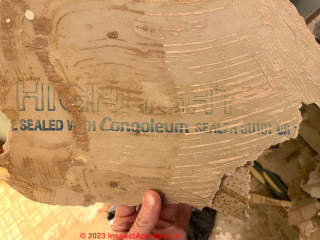
On 2023-02-28 by InspectApedia Editor - Gold Seal Congoleum No. 703 from the 1942 Congoleum Nairn Flooring Catalog
@Jay,
If you want to remove it, even if asbestos containing, there are best practices for how to do that. So testing positive for asbestos doesn't necessarily mean you have to keep it. If you want to get it tested to know for sure - fine, but it's not necessary. If not testing it, just treat it as if it did contain asbestos.
See
ASBESTOS FLOORING REMOVAL GUIDE
https://inspectapedia.com/hazmat/Asbestos-Floor-Removal.php
Where we discuss the best ways to do so including our list of
Asbestos Containing Flooring Do's And Dont's for the Homeowner
No worries about the photo order. The Comment Box software that we use (from countable.ca) only allows one photo per comment so feel free to post as many comments and thus photos as you wish.
On 2023-02-28 by Jay
@InspectApedia Editor ,
Thank you. I guess we'll go ahead and get it tested, because we would like to remove it. If it contains asbestos we will probably leave it in place and just cover it.
Sorry the photos are all out of order and not under the post. I could only upload one photo at at time and to do it under a new comment each time.
On 2023-02-28 by InspectApedia Editor
@Jay,
Thanks for these photos and for finding and identifying the pattern.
The 'best' thing, and the simplest and safest thing to do is to leave the flooring in place and cover it with new flooring or seal it. Neither of these options would require testing.
If you do need to remove it, use the Search box at the top or bottom of any of our website pages and search for these articles:
ASBESTOS FLOORING HAZARD REDUCTION
ASBESTOS FLOORING REMOVAL GUIDE
Those discussions will give you the information you need to treat this flooring which could presumed asbestos containing material (PACM).
Let us know if you have additional questions.
On 2023-02-28 by Jay
More photos - including one from 1942 catalog
On 2023-02-28 by Jay
We discovered what appears to be a solvent wiped or somehow degraded Gold Seal Congoleum No. 703 from the Congoleum-Nairn-Flooring-Catalog-1942.pdf. See what you think. It appears to be the same material in the closet, but with its pattern still intact.
Photos show under carpet, in closet, and screenshot from provided pdf catalog. It doesn't seem to have any backing material. I'm having a hard time finding further info about it here on the site.
Any further info would be most appreciated, but I suppose the best thing is to get it tested before removal?
On 2023-01-01 by InspectApedia Editor
@Caiti,
If the flooring is from the 90s and you live in the US, it would not contain asbestos as it was discontinued in the US in 1986. If it is from 1972, and short of having it tested, then it's best to treat it as presumed asbestos containing material (PACM).
Keep in mind that the safest and simplest method to deal with PACM is to cover with new flooring.
If you did choose to have it tested, and you broke off a small piece to do so, you could damp wipe any dust (which would be minimal) to allay your concerns.
Please see the information found at the live link above in the Recommended Articles list for
DOES THIS FLOOR CONTAIN ASBESTOS?
5 easy questions to tell if your FLOOR probably contains asbestos
Keep in mind that the hazard from a little bit of flooring that breaks away is probably below the limits of detection. Damp wipe or HEPA vac to clean-up anything that's questionable, then consider our advice for re-covering the floor.
On 2023-01-01 by Caiti
Hi! My house was built in 1972 and has vinyl sheet flooring in the kitchen. The edges are breaking off and I’m nervous that it contains asbestos. (I have a 9mo old crawling). The kitchen has definitely been updated and I’m thinking during the early 90s based on the cabinets/appliances I’ve been able to find on the internet.
But I can’t find this specific flooring anywhere… I will probably get the flooring tested but don’t really want to disturb it for a sample. Any insight helps!
Question: does this 1960s Congoleum DuraStone HPF flooring contain asbestos?
(Asbestos: yes, but this floor may not be DuraStone)
Looking through your pages I couldn’t find any reference to this product. Looking to find if we should have it analyzed for asbestos.
My best guess is that it was installed circa early 60’s in our basement.
An interior French drain was installed about 20 years ago and the tile is broken up at the border there.
Shown here: a photo of the reader's 9x9 floor tiles from a 1980s installation that MIGHT be Congoleum DuraStone HPF flooring - [the reader later decided it may be something else.- Ed.] - Anonymous by private email 2020/10/21
See below the asbestos test results for this flooring later provided by this reader and performed by Schneider Laboratories in 2020:
- VINYL ASBESTOS FLOOR TILE TEST RESULT [PDF] 2020/10/13 confirming 2% Chrysotile asbestos and 98% non-fibrous material.
Moderator reply:
Modern Congoleum DuraStone HPF flooring, introduced in 2001, does not contain asbestos.
But to date I have been unable to find a trusted resource that confirms the presence or absence of asbestos in older Congoleum DuraStone HPF flooring.
Are you confident that your floor tiles were installed are a DuraStone product?
Interestingly the company's own self-reported history does not include the "Dura-" product name until its introduction of DuraCeramic, "a patented revolutioniary luxury vinyl tile introduced to the market" in 2003. But, then, that resource, cited below, does not include the word "asbestos" at all. Yet we know that many (not all) older Congoleum flooring products contained asbestos.
In 2003, in response to liability from asbestos hazard or injury claims, Congoleum Nairn filed for bankruptcy under Chapter 11 on 31 December 2003.
Congoleum's history is given in detail
at FLOOR TILE HISTORY & INGREDIENTS
I will continue to research this question; if you decide to have a sample of the flooring tested please give me copy of those results as it will help other readers.
Also keep in mind that some tile adhesive mastics also contained asbestos.
I would treat the floor as presumed to contain asbestos and, if there is no damage other than minor at the floor perimeter, I'd guess that safest and most-economical for you
would be to leave the flooring alone, in place, and to cover it over.
Note that there is also a current Congoleum DuraStone HPF (High Performance Flooring) product line available to consumers and released as a"new product" on my birthday, 10 September 2001.
That flooring product would not contain asbestos, as no contemporary flooring products do.
Shown below: two samples of current (October 2020) DuraStone floor tiles as sold by Lowes building suppliers. These floor tiles will not contain asbestos.
The 2012 Congoleum DuraStone HPF flooring instructions given just above include the following warning and notice:
WARNING
Do not sand, dry sweep, dry scrape, drill, saw, beadblast, or mechanically chip or pulverize existing resilient flooring,backing, lining felt, asphaltic “cutback” adhesive, or other adhesive. These products may contain asbestos fibers and/or crystalline silica.
Avoid creating dust. Inhalation of such dust is a cancer and respiratory tract hazard. Smoking by individuals exposed to asbestos fibers greatly increases the risk of serious bodily harm. Unless positively certain that the product is a non-asbestos containing material, you must presume it contains asbestos.
Regulations may require that the material be tested to determine asbestos content and may govern the removal and disposal of material. Whenever possible, existing flooring should be left in place and the new floor installed over the top.
If you must remove old flooring material, contact your retailer or Congoleum Corporation, Installation Department, P.O. Box 3127, Mercerville, NJ 08619, for a copy of recommended work practices for the removal of resilient floor coverings. These practices should be followed
NOTICE
Various federal, state and local government agencies have regulations covering the removal of in-place asbestos containing material. If you contemplate the removal of a resilient floor covering structure that contains (or is presumed to contain)asbestos, you must review and comply with all applicable regulations.
Regulations outside the United States may vary.
Copies of the Resilient Floor Covering Institute (RFCI)Recommended Work Practices for the Removal of Resilient Floor Coverings are available from:
Congoleum Corporation
Installation Department
P.O. Box 3127
Mercerville, NJ 08619
Resilient Floor Covering Institute
401 East Jefferson Street
Suite 102 Rockville, MD 20850
Please note that the RFCI Recommended Work Practices are subject to change as new practices are incorporated. It is you responsibility to determine that the recommended work practices you use are those in effect.
Reader follow-up:
I took a look at the web posting, thanks! As for the question on is this really a Congoleum DuraStone HPF product - I now believe it is not. Although I found the Installation Instructions tucked in an original box with a dozen or so of these tiles, it could have come from a different set of tiles. At the time I considered the box too decayed to be of value. Wish I had it now. In fact I have found in some construction records on an addition from 2002, reference to an installation of “Dura Stone - Vineyard #VY13 - Stone White”. Enough to make me very suspicious of my initial ID, I did think it curious they included such explicit warnings about asbestos in existing flooring if the new product did in fact include asbestos.
So I would edit the post to remove it from the Congoleum list and remove the instructions PDF.
Just for the sake of completeness, here is page two of the instructions. I notice the mailing address included here is the same as the apparent current address you list.
I have had the tiles analyzed. It would be nice to know what the confidence intervals are but it appears I have no choice but to treat it as asbestos containing (although the mastic is not it makes little difference for my purposes I think). - Anonymous by private email 2020/10/21
On 2020-08-31 - by (mod) - Tests found no asbestos in this Congoleum Nairn flooring
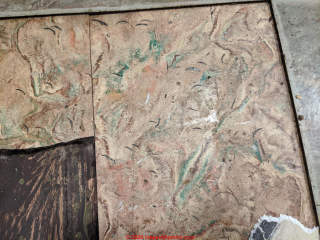 Charis,
Charis,
Thank you for taking the time to post a photo and asbestos test results for your Congoluem flooring.
Can you tell us
The age of the building where this floor is installed?
The country and city of its location?
And yes photos of the underside of the floor and of any markings or stamps on it would be helpful.
Also, did you test the mastic adhesive for asbestos too?
On 2020-08-25 by Charis
Congoleum Nairn sheet flooring [shown just above] tested negative for asbestos. I don't know what year it's from but I have pics of the front and underneath.
On 2020-07-30 by (mod)
Yes, Robert.
On 2020-07-28 by Robert
Has anyone seen this pattern in asbestos positive cases? Is said Congoleum near one edge and I presume was original to the house in 1971.
On 2020-07-09 - by (mod) -
That's a linoleum sheet flooring product - I look forward to seeing if you find markings on the back of it.
You will find similar patterns and catalogs that may have your exact patterns at (live links above at More Reading
1947 CONGOLEUM SHEET FLOORING
1940s CONGOLEUM GOLD SEAL RUGS vs. NAIRN LINOLEUM ingredient differences
1950 CONGOLEUM GOLD SEAL SHEET FLOORING - No Asbestos
and
LINOLEUM & OTHER SHEET FLOORING - home
Some of these used asbestos- most-often in the felt backer.
Please do let us know your lab test results as that will help other readers.
On 2020-07-09 by Beth
After removing about 3/4 inch of layers of vinyl and underlayment in the kitchen, I arrived at what is probably the original flooring for my 1938 house.
I'm waiting on the results from asbestos testing before I pull it up. In the meantime, I'm curious if anyone recognizes the maker, brand, pattern? Thank you!
On 2020-05-20 b - by (mod) -
Possibly yes.
On 2020-05-20 by Sheika
Does this double layered vinyl floor appear with white powdery Asbestos adhesive ?
On 2020-04-26 - by (mod) -
Possibly, If you post a photo
You might also look through the Nairn catalogs
On 2020-04-26 1b by Roberta
Hi
I have just removed some old vinyl flooring from a summerhouse. The mark on the back is Nairn Cushionflor. It looks like the 70s or 80s beige and brown tile design. I just ripped it up. I am concerned now it contained asbestos.
My house was built in the 1950’s and I would think the summerhouse has been there since the late 60s. Can anyone help identify it. There are no other names on the backing or numbers.
...
Continue reading at 1960's CONGOLEUM FLOORING or select a topic from the closely-related articles below, or see the complete ARTICLE INDEX.
Or see these CONGOLEUM-NAIRN FLOOR TILES & LINOLEUM FAQs - questions & answers about identifying Congoleum flooring and which products contained asbestos, posted originally on this page.
Or see these
Recommended Articles
- ASBESTOS PRODUCING COMPANIES & TRUSTS - see entry for Congoleum in this file
- ASBESTOS TESTING LAB LIST
- ASBESTOS TILE MANUFACTURE
- CONGOLEUM FLOORING HISTORY
- CONGOLEUM-NAIRN FLOOR TILES & LINOLEUM
- 1928 CONGOLEUM RUGS SHEET FLOORING - Canadian Congoleum
- 1940s CONGOLEUM FLORAL RUG PATTERNS
- 1947 CONGOLEUM SHEET FLOORING
- 1940s CONGOLEUM GOLD SEAL RUGS vs. NAIRN LINOLEUM ingredient differences
- 1950 CONGOLEUM GOLD SEAL SHEET FLOORING - No Asbestos
- 1950's CONGOLEM SHEET FLOORING Products Resembling Individual Floor Tiles
- 1960's CONGOLEUM FLOORING - No Asbestos
- 1970's CONGOLEUM FLOORING
- 1970's CONGOLEUM FLOORING in AUSTRALIA
- 1980 CONGOLEUM NO-WAX SHEET FLOORING - With Asbestos-Content.
- WHITE SHIELD BACKING ASBESTOS in FLOORING
- DOES THIS FLOOR CONTAIN ASBESTOS? - 5 easy questions to tell if your FLOOR probably contains asbestos -
- DOMINION & Other CANADIAN FLOORING ASBESTOS
- FLOOR TILE / SHEET FLOORING PHOTO GUIDES
- IDENTIFY SHEET FLOORING TYPE, HOW TO
- LINOLEUM & OTHER SHEET FLOORING - home
- SHEET FLOORING INSPECT / TEST
- WHITE SHIELD® BACKING ASBESTOS in FLOORING
Suggested citation for this web page
CONGOLEUM-NAIRN FLOOR TILES & LINOLEUM at InspectApedia.com - online encyclopedia of building & environmental inspection, testing, diagnosis, repair, & problem prevention advice.
Or see this
INDEX to RELATED ARTICLES: ARTICLE INDEX to ASBESTOS HAZARDS
Or use the SEARCH BOX found below to Ask a Question or Search InspectApedia
Ask a Question or Search InspectApedia
Try the search box just below, or if you prefer, post a question or comment in the Comments box below and we will respond promptly.
Search the InspectApedia website
Note: appearance of your Comment below may be delayed: if your comment contains an image, photograph, web link, or text that looks to the software as if it might be a web link, your posting will appear after it has been approved by a moderator. Apologies for the delay.
Only one image can be added per comment but you can post as many comments, and therefore images, as you like.
You will not receive a notification when a response to your question has been posted.
Please bookmark this page to make it easy for you to check back for our response.
Our Comment Box is provided by Countable Web Productions countable.ca
Citations & References
In addition to any citations in the article above, a full list is available on request.
- "Asbestos in your home or at work," Forsyth County Environmental Affairs Department, Winston-Salem NC 12/08
- "Asbestos Floor Tile Removal", the University of Minnesota's advice on removing VAT (vinyl asbestos or asphalt asbestos floor tile) can be read in detail at www.health.state.mn.us/divs/eh/asbestos/floortile/index.html
- EPA, ASBESTOS IN YOUR HOME [PDF] - U.S. EPA, Exposure Evaluation Division, Office of Toxic Substances, Office of Pesticides and Toxic Substances, U.S. Environmental Protection Agency, Washington,D.C. 20460
- Resilient Floor Covering Institute, 1030 15th St. NW, suite 350, Washington D.C.
- Congoleum Corporation, "Company History", Congoleum Corporation, Department C, P.O. Box 3127, Mercerville, NJ 08619-0127 1-609-584-3601, web-search 03/14/2011, original source: http://www.congoleum.com/history.html
- David Grudzinski, Advantage Home Inspections, is a professional home inspector in Cranston, RI. 02910. He can be reached at 401-935-6547, fax- 401-490-0607 or by email to contact/us@advantagehomeinspections.us 04/26/2009
- EPA Guidance for Controlling Asbestos-Containing Materials in buildings, NIAST, National Institute on Abatement Sciences & Technology, [republishing EPA public documents] 1985 ed., Exposure Evaluation Division, Office of Toxic Substances, Office of Pesticides and Toxic Substances, U.S. Environmental Protection Agency, Washington,D.C. 20460
- "Plastic Flooring Spreads Through the House", Jackson Hand, Guide to Home-Improvement Materials, Popular Science, April 1969, p. 154-158
- Thomas Hauswirth, Managing Member of Beacon Fine Home Inspections, LLC and (in 2007) Vice President, Connecticut Association of Home Inspectors Ph. 860-526-3355 Fax 860-526-2942 beaconinspections@sbcglobal.net 06/07: thanks for photographs of transite asbestos heating ducts
- Gary Randolph, Ounce of Prevention Home Inspection, LLC Buffalo, NY, for attentive reading and editing suggestions. Mr. Randolph can be reached in Buffalo, NY, at (716) 636-3865 or email: gary@ouncehome.com 3/07
- M.B. provided photographs of Congoleum linoleum flooring from a 1960's Tampa Florida home.
- ASBESTOS IN YOUR HOME U.S. EPA, Exposure Evaluation Division, Office of Toxic Substances, Office of Pesticides and Toxic Substances, U.S. Environmental Protection Agency, Washington,D.C. 20460
- "Handling Asbestos-Containing roofing material - an update", Carl Good, NRCA Associate Executive Director, Professional Roofing, February 1992, p. 38-43
- EPA Guidance for Controlling Asbestos-Containing Materials in buildings, NIAST, National Institute on Abatement Sciences & Technology, [republishing EPA public documents] 1985 ed., Exposure Evaluation Division, Office of Toxic Substances, Office of Pesticides and Toxic Substances, U.S. Environmental Protection Agency, Washington,D.C. 20460
- In addition to citations & references found in this article, see the research citations given at the end of the related articles found at our suggested
CONTINUE READING or RECOMMENDED ARTICLES.
- Carson, Dunlop & Associates Ltd., 120 Carlton Street Suite 407, Toronto ON M5A 4K2. Tel: (416) 964-9415 1-800-268-7070 Email: info@carsondunlop.com. Alan Carson is a past president of ASHI, the American Society of Home Inspectors.
Thanks to Alan Carson and Bob Dunlop, for permission for InspectAPedia to use text excerpts from The HOME REFERENCE BOOK - the Encyclopedia of Homes and to use illustrations from The ILLUSTRATED HOME .
Carson Dunlop Associates provides extensive home inspection education and report writing material. In gratitude we provide links to tsome Carson Dunlop Associates products and services.


